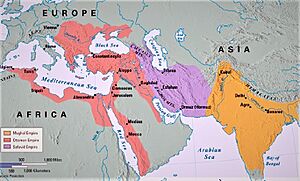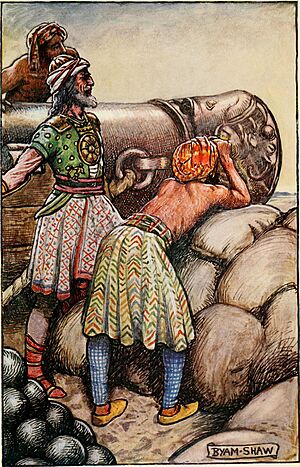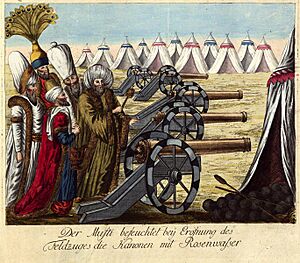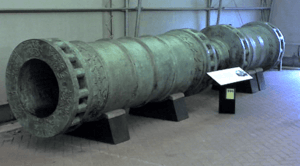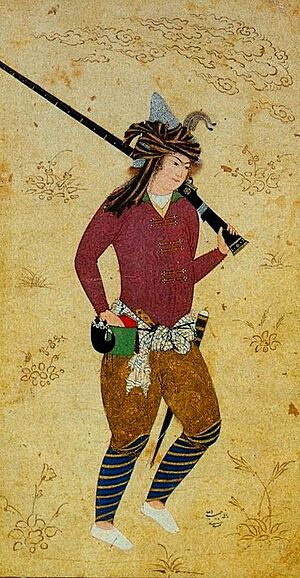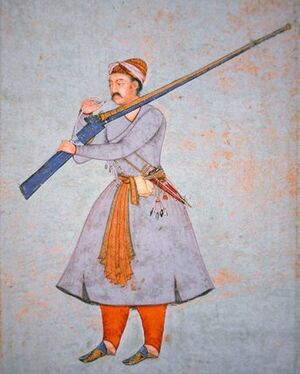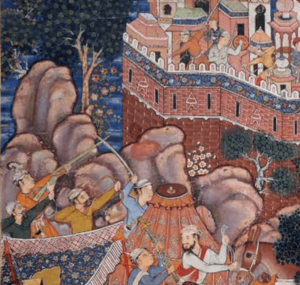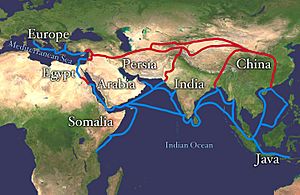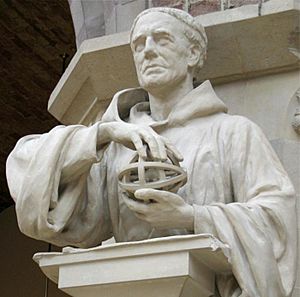Gunpowder empires facts for kids
The Gunpowder Empires is a name given to three powerful Muslim empires that existed from the mid-1500s to the early 1700s. These were the Ottoman Empire, the Safavid Empire in Iran, and the Mughal Empire in India. Historians Marshall G. S. Hodgson and William H. McNeill from the University of Chicago first used this term.
These empires were very stable during their time. They grew their trade, supported arts and culture, and made their governments stronger. They stretched across a huge area, from Central Europe and North Africa all the way to India. These empires conquered vast lands by using and improving new weapons like firearms, especially cannons and smaller guns. Just like in Europe, these new weapons helped create strong, central governments.
The changes brought by gunpowder went beyond just the military. The Mughals, based in India, were known for their amazing buildings and for starting a period of early industrial growth in Bengal. The Safavids created a very effective government in Iran and supported great art. The Ottoman sultans controlled the holy cities of Mecca and Medina, making them important leaders in the Islamic world. Their power, wealth, and buildings greatly shaped Islamic history.
Contents
What are the Gunpowder Empires?
The idea of "Gunpowder Empires" was created by historians Marshall G. S. Hodgson and William H. McNeill. Hodgson wrote about these empires in his book The Venture of Islam. He believed that gunpowder weapons were key to these "military patronage states." These states were different from earlier, less stable groups of Turkic clans.
Hodgson described a "military patronage state" as having three main features:
- The rulers had their own special laws.
- The entire country was seen as one big military force.
- All money and cultural resources were controlled by the main military families.
These ideas came from the Mongol Empire. But these states could only become strong and organized empires once gunpowder weapons became very important in warfare.
McNeill added that if a state could control the new artillery, its leaders could unite larger areas into new or stronger empires. This control was very important. Europe developed new artillery in the 1400s, but no single European country controlled it all. This led to a balance of power. But in places like Western Asia, Russia, and India, states were able to control these weapons. This helped them create powerful, military-focused empires.
New Ideas About the Concept
Recently, some historians have questioned the "gunpowder empire" idea. They say it might not fully explain why these empires grew so quickly. They suggest other reasons, besides military technology, for the rise of these three strong empires in areas where decentralized Turkic tribes used to rule.
One idea is "Confessionalization." This looks at how the relationship between religion and government helped create strong, absolute rulers. For example, the Safavids introduced a new religious identity to their people. This helped create a sense of national identity, even if that wasn't their main goal.
Another point is that these empires often gained their first territories before they fully adopted firearms. This was true for the Ottomans and Safavids, but less so for the Mughals. Also, the idea of having a strong military ruler was already present before gunpowder weapons became common. However, it's clear that all three empires quickly adopted artillery and firearms. They made these weapons a key part of their military plans.
Historian Michael Axworthy noted that the Safavid army mostly used swords, lances, and bows until the mid-1700s. It wasn't until Nader Shah's rule that most Iranian soldiers were equipped with firearms. This suggests the "gunpowder" label might not fit the Safavids as perfectly as the others.
Gunpowder Empires of the Muslim World
Ottoman Empire
The Ottoman Empire was the first of the three to use gunpowder weapons. By the 1300s, the Ottomans had started using gunpowder artillery. They adopted these weapons so quickly that they were ahead of both their European and Middle Eastern enemies. They were the first to have permanent, specialized troops who made and used firearms. Their use of artillery surprised their enemies and pushed the other two Islamic empires to get their own weapons faster.
The Ottomans used cannons in sieges of Constantinople in 1399 and 1402. They proved how useful they were in the successful siege of Salonica in 1430. The Ottomans used foundries from both the Middle East and Europe to make their cannons. By the Fall of Constantinople in 1453, they had cannons large enough to break down the city walls, which shocked the defenders.
The Ottoman military used firearms regularly, even more than their European rivals. The Janissaries were originally infantry who used bows and arrows. But under Sultan Mehmed II, they were trained with firearms. They became perhaps the first standing army in the world to be equipped with firearms. The Janissaries are seen as the first modern standing army. The power of Ottoman artillery combined with Janissary firepower led to important victories. These included the Battle of Varna in 1444 against Crusaders, Başkent in 1473, and Mohács in 1526 against Hungary. But the battle that truly showed the Safavids and Mughals how effective gunpowder was, was the Battle of Chaldiran.
The matchlock arquebus was used by the Janissaries by the 1440s. The musket appeared in the Ottoman Empire by 1465. Damascus steel was used to make firearms like muskets from the 1500s. At the Battle of Mohács in 1526, Janissaries used 2,000 tüfenks (muskets). They fired in nine rows, one after another, from a kneeling or standing position. The Chinese later copied this kneeling firing position. In 1598, a Chinese writer named Zhao Shizhen said that Turkish muskets were better than European ones. A Chinese book from 1621 described Turkish muskets that used a special gear system, which was not known in European or Chinese firearms at the time.
The Dardanelles Gun was made in 1464. This huge bronze cannon was still in use more than 340 years later in 1807. When a British navy force arrived, Turkish soldiers loaded the old cannon and fired it at the British ships. This bombardment caused 28 casualties for the British.
At Chaldiran, the Ottomans fought the Safavids for the first time. In 1514, Sultan Selim I moved his army east to face what he saw as a threat from Shah Ismail. Ismail believed he was a divinely-favored ruler and charged his cavalry directly at the Ottoman position. The Ottomans placed their cannons between carts, which also protected their armed Janissaries. The Safavid cavalry suffered huge losses. The defeat was so complete that the Ottomans briefly took the Safavid capital, Tabriz. The Ottoman army's limited travel distance was the only reason they didn't hold the city and end Safavid rule.
Safavid Empire
The defeat at Chaldiran stopped Ismail's plans to expand his territory. But the shah quickly took steps to protect his empire from the Ottomans. He armed his troops with gunpowder weapons. Within two years of Chaldiran, Ismail had 8,000 musketeers (tofangchi). By 1521, he might have had 20,000. After Abbas the Great reorganized the army around 1598, the Safavid forces had 500 cannons and 12,000 musketeers.
The Safavids first used their gunpowder weapons against the Uzbeks. The Uzbeks had invaded eastern Persia after Ismail I died. The young shah Tahmasp I led an army to help Herat. On September 24, 1528, they met the Uzbeks at Jam. The Safavids won a decisive victory. The shah's army placed cannons (small guns on wagons) in the center, protected by wagons. Cavalry was on both sides. The Mughal emperor Babur said the formation at Jam was "in the Anatolian fashion," like the Ottomans. Several thousand gun-carrying infantry also gathered in the center, like the Ottoman Janissaries. Even though the Uzbek cavalry attacked and turned the Safavid army on both sides, the Safavid center held strong. Tahmasp led his infantry, who then attacked and scattered the Uzbek center, winning the battle.
Mughal Empire
By the time he was invited by the Lodi governor of Lahore, Daulat Khan Lodi, to help him rebel against Sultan Ibrahim Khan, Babur already knew about gunpowder firearms and field artillery. He also knew how to use them in battle. Babur hired an Ottoman expert, Ustad Ali Quli. Ali Quli showed Babur the standard Ottoman formation: artillery and infantry with firearms in the center, protected by wagons, and mounted archers on both sides.
Babur used this formation at the First Battle of Panipat in 1526. The Afghan and Rajput forces, loyal to the Delhi sultanate, had more soldiers but no gunpowder weapons. They were defeated. Babur also used these weapons to win the important Battle of Khanwa against the larger Rajput confederacy. The strong victory of Babur's forces meant that enemies rarely fought Mughal princes in open battles throughout the empire's history.
The reigns of Akbar the Great, Shah Jahan, and Aurangzeb are seen as a golden age in Indian history. By Aurangzeb's time, the Mughal army was mostly made up of Indian Muslims. Groups like the Sadaat-e-Bara formed the front lines of the Mughal cavalry. The Mughal Empire became a very powerful force, at times having 24.2% of the world's population. The Mughals, like the Ottomans and Safavids, adopted parts of Persian culture and art. Indian Muslims kept artillery important in India. Even after the Mughal empire fell, other Indian kingdoms continued to hire Hindustani Muslims as artillery officers in their armies.
Gunpowder in Europe
Europeans are known for pushing gunpowder technology to its limits. They improved existing formulas and found new ways to use gunpowder after it arrived in Europe via the Silk Road in the 1200s. Europeans were improving gunpowder about a century after the first gun was invented in China.
Roger Bacon, a famous early European alchemist (1214–1292), wrote about the wonders of the world, including the ingredients of gunpowder. With these ingredients, European scientists and inventors created "corned gunpowder." This was made by adding a wet substance to gunpowder and then drying it as a mixture. This improved gunpowder led to the invention of the first European cannon by German friar Berthold Schwarz in 1353.
Because of constant wars, Europe saw a huge increase in gunpowder firearm innovations. This made European firearms the most advanced in the world. Europeans improved the gunpowder firearms that had been made in China and the Middle East. They created much stronger and more durable rifles using advanced European metalworking skills. They learned how to calculate the force of the gas inside a gun's chamber. This led to guns that could fire much farther.
Improved gunpowder from Europe later reached China in 1520 on a Portuguese ship. However, Turkish arquebuses might have arrived in China even earlier. The Ottomans and Portuguese introduced cannons, improved rifles, and other advancements to China. This happened hundreds of years after gunpowder was first invented in China, bringing gunpowder's journey through Asia full circle.
Images for kids
See also
- History of gunpowder
- Political history of the world
- Timeline of the gunpowder age


